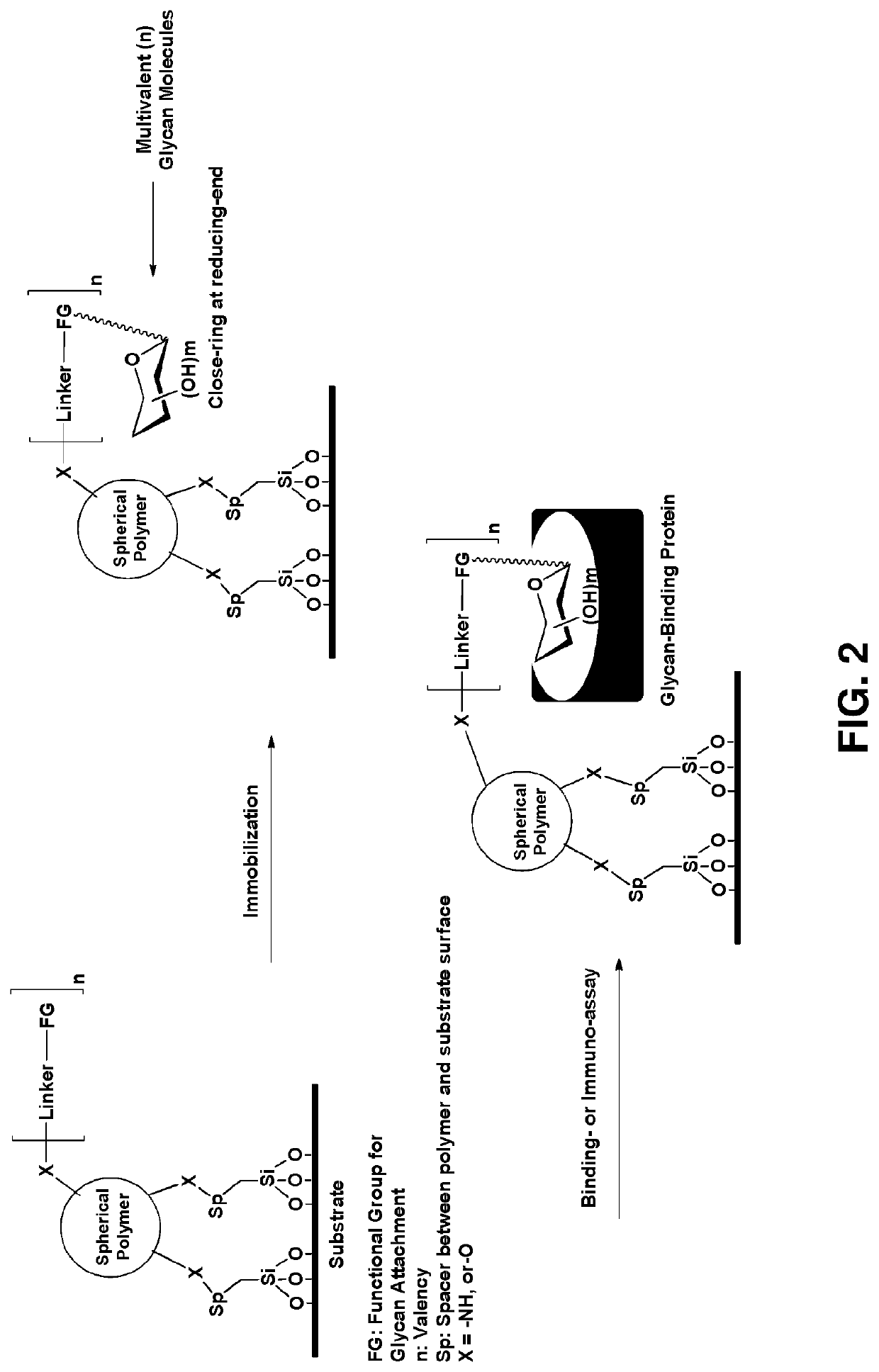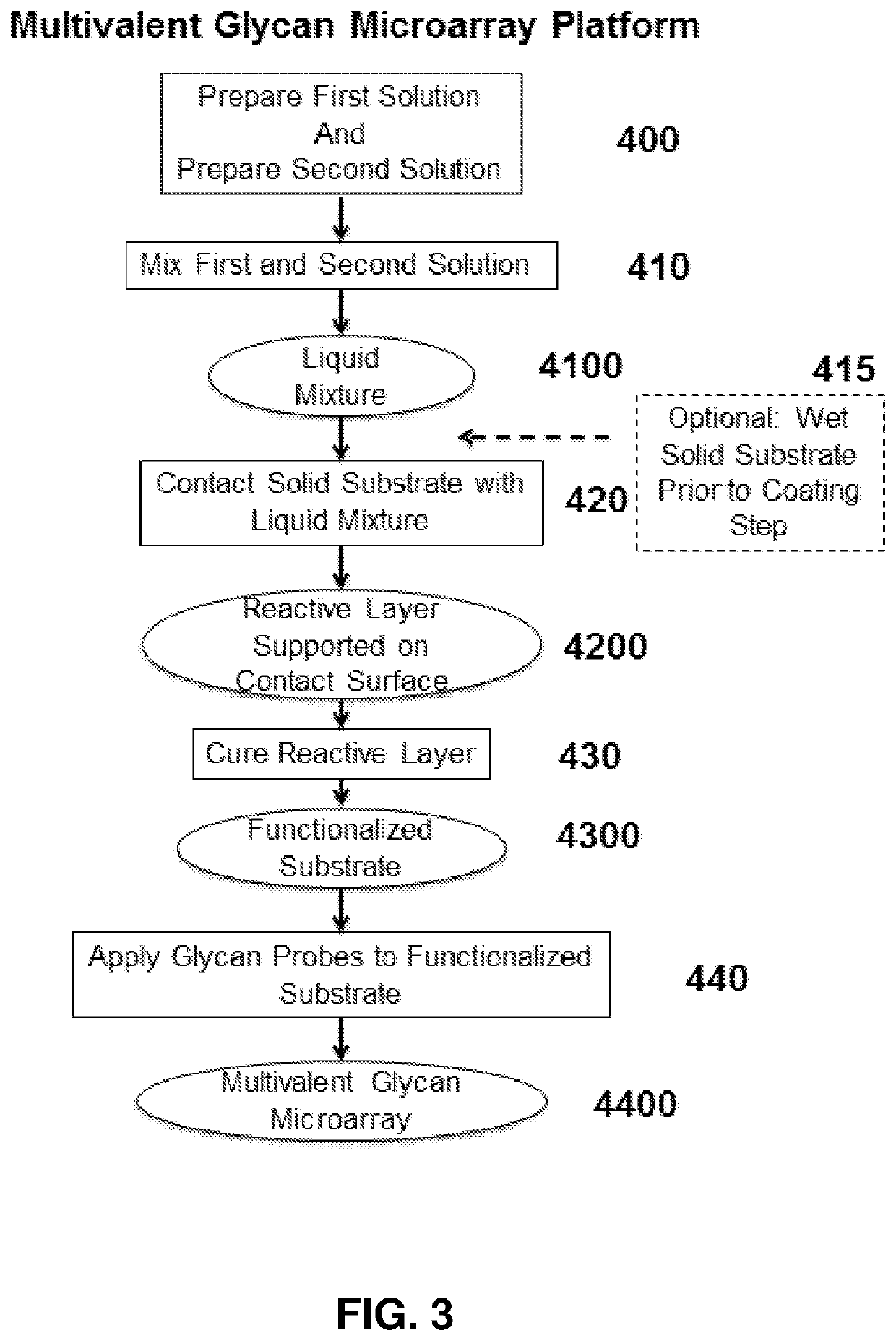Multivalent glycan microarray platform
a microarray and glycan technology, applied in the field of multivalent glycan microarray platforms, can solve the problems of labor-intensive and time-consuming synthesis of glycans, and achieve the effects of improving site density, rapid identification of interactions, and enhancing binding affinity for proteins
- Summary
- Abstract
- Description
- Claims
- Application Information
AI Technical Summary
Benefits of technology
Problems solved by technology
Method used
Image
Examples
example 1
on of a Polyamidoamine (PAMAM) Dendrimer Generation 2 Coating Functionalized with N-Hydroxysuccinimide (NHS) Groups on Glass Slides
[0096]Microscope slides are cleaned with 2% Valtron SP2275 detergent in sonication bath heated to 60° C. Then they are dried in a vacuum oven at 100° C. for 30 minutes. A coating Solution A, the first solution, or “active coating mixture,” is prepared by mixing 10 mM (3-Glycidyloxypropyl)trimethoxysilane (GOPS) and 2.5 mM PAMAM dendrimer generation 2 in DMSO. Amounts of 5, 10 and 20 mM GOPS were tested and 10 mM selected; amounts of 0.5 mM, 1 mM, 1.5 mM, 2 mM, 2.5 mM, 3 mM, 3.5 mM, 4 mM, 4.5 mM, and 5 mM were tested and 2.5 mM selected. All amounts tested were successful. The mixture is stirred for 30 minutes. In a separate vial, 40 mM N,N′-disuccinimidyl carbonate is dissolved in DMSO and the solution is added dropwise to the mixture containing GOPS and dendrimer (form Solution A). Amounts of 40 mM and 80 mM N,N′-disuccinimidyl carbonate were tested and...
example 2
on of a Polyamidoamine (PAMAM) Dendrimer Generation 2 Coating Functionalized with Hydrazide Groups on Glass Slides
[0097]Microscope slides are cleaned with 2% Valtron SP2275 detergent in sonication bath heated to 60° C. Then they are dried in a vacuum oven at 100° C. for 30 minutes. A coating Solution A, the first solution, or active coating mixture, is prepared by mixing 10 mM (3-Glycidyloxypropyl)trimethoxysilane (GOPS) and 2.5 mM PAMAM dendrimer generation 2 in DMSO. The mixture is stirred for 30 minutes. In a separate vial, 40 mM N,N′-disuccinimidyl carbonate is dissolved in DMSO and the solution is added dropwise to the mixture containing GOPS and dendrimer. The mixture is stirred for additional 30 minutes. Then 80 mM adipic acid dihydrazide (48, 56, 64, 72 and 80 mM were tested successfully) is added to the mixture and stirred for additional 30 minutes (form Solution A). A coating Solution B, the second solution, or the blocking mixture, is prepared by mixing 4.52 mM poly(ethyl...
example 3
on of an 8-Arm Polyethylene Glycol (PEG) Coating Functionalized with N-Hydroxysuccinimide (NHS) Groups on Glass Slides
[0098]Microscope slides are cleaned with 2% Valtron SP2275 detergent in sonication bath heated to 60° C. Then they are dried in a vacuum oven at 100° C. for 30 minutes. A coating Solution A, the first solution, or active coating mixture, is prepared by mixing 10 mM (3-glycidyloxypropyl)trimethoxysilane (GOPS) and 5 mM 8arm-PEG-NH2, hexaglycerol core in DMSO. The mixture is stirred for 30 minutes. In a separate vial, 40 mM N,N′-disuccinimidyl carbonate is dissolved in DMSO and the solution is added dropwise to the mixture containing GOPS and PEG (form Solution A). The first solution, Solution A, is stirred for additional 30 minutes. The second solution, coating Solution B, or the blocking mixture, is prepared by mixing 4.52 mM poly(ethylene glycol) sorbitol hexaoleate and 8.26 mM 6-azidosulfonylhexyltriethoxy silane in DMSO. The second solution, Solution B, mixture is...
PUM
| Property | Measurement | Unit |
|---|---|---|
| molecular-weight | aaaaa | aaaaa |
| molecular-weight | aaaaa | aaaaa |
| temperature | aaaaa | aaaaa |
Abstract
Description
Claims
Application Information
 Login to View More
Login to View More - R&D
- Intellectual Property
- Life Sciences
- Materials
- Tech Scout
- Unparalleled Data Quality
- Higher Quality Content
- 60% Fewer Hallucinations
Browse by: Latest US Patents, China's latest patents, Technical Efficacy Thesaurus, Application Domain, Technology Topic, Popular Technical Reports.
© 2025 PatSnap. All rights reserved.Legal|Privacy policy|Modern Slavery Act Transparency Statement|Sitemap|About US| Contact US: help@patsnap.com



